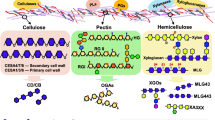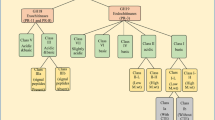Abstract
Polygalacturonase (PG) and polymethylgalacturonase (PMG) activity was recorded in the two non-ripening mutants of tomato devoid of these enzymes, rin and nor fruits, following Rhizopus stolonifer infection. Activity increased markedly with disease development.
Cx-cellulase activity, generally found in healthy rin and normal fruit, increased with maturity as well as with disease development. The effect of fungal infection on Cx-activity was particularly pronounced on the mature-green nor fruit, in which only traces of activity were recorded prior to inoculation.
At an advanced stage of disease development, infection brought pectolytic and cellulolytic activity in the standard and mutant fruits at all stages of maturity to a similar level, regardless of the differences in their initial enzyme levels. A correlation was drawn between the level of pectolytic activity and the rate of fruit softening in Rhizopus-infected mutant fruits. Tissue softening following infection was attributed to the activity of fungal polygalacturonases. The relatively high levels of Cx-cellulase found in infected mutants during the early stages of disease development, when only a slight or no softening was recorded, suggested a lack of relationship between cellulolytic activity and softening of tomato tissues.
Similar content being viewed by others
References
Babbit, J. K., Powers, M. J. & Patterson, M. E., 1973. Effects of growth regulators on cellulase, polygalacturonase, respiration, color and texture of ripening tomatoes. J. Am. Soc. Hort. Sci. 98: 77–81.
Barkai-Golan, R., 1974. Production of cellulase and polygalacturonase by Sclerotina minor. Mycopth. Mycol. Appl. 54: 297–302.
Barkai-Golan, R. & Kopeliovitch, E., 1980. Storage diseases of standard rin and nor tomato fruits. Prelim. Rep. Agric. Res. Orgn, Bet Dagan, Israel No. 782 (Hebrew, with English summary).
Barkai-Golan, R. & Kopeliovitch, E., 1981. Resistance of rin and nor tomato mutants to postharvest Rhizopus infection. Ann. Appl. Biol. 98: 289–293.
Buescher, R. W. & Tigchelaar, E. C., 1977. Utilization of nor tomato hybrids for extending storage life and improving processed quality. Lebensm. Wiss. u. Technol. 10: 111–113.
Herner, R. C. & Sink, K. C., Jr., 1973. Ethylene production and respiration behavior of the rin tomato mutant. Plant Physiol. 52:38–41.
Hobson, G. E., 1965. The firmness of tomato fruit in relation to polygalacturonase activity. J. Hort. Sci. 40: 66–72.
Ng, T. J. & Tigchelaar, E. C., 1977. Action of the non-ripening (nor) mutant on fruit ripening of tomato. J. Am. Hort. Sci. 102: 504–509.
Robinson, R. W. & Tomes, M. L., 1968. Ripening inhibitor: a gene with multiple effects on ripening. Tomato Genet. Coop. 18: 36–37.
Spalding, D. H., 1963. Production of pectinolytic and cellulolytic enzymes by Rhizopus stolonifer. Phytopathology 53: 929–931.
Tigchelaar, E. C., Tomes, M. L., Kerr, A. E. & Barman, R. J., 1973. A new ripening mutant, non-ripening (nor). Tomato Genet. Coop. 23: 33–34.
Author information
Authors and Affiliations
Rights and permissions
About this article
Cite this article
Barkai-Golan, R., Kopeliovitch, E. Pectolytic and cellulolytic activity in Rhizopus-infected rin and nor tomato mutants. Mycopathologia 82, 89–93 (1983). https://doi.org/10.1007/BF00437336
Issue Date:
DOI: https://doi.org/10.1007/BF00437336




